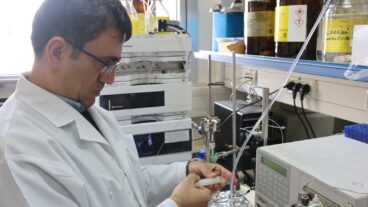Dr. Hedva Lerman: We are probably the first to report the benefits of SPECT/CT for sentinel node detection, and certainly the first to use it for breast cancer.With breast cancer leading the pack as the second most common cause of cancer death in women, early detection and an accurate diagnosis are crucial to a breast cancer patient’s chances for survival. There is one snag: doctors have reported difficulty detecting sentinel nodes (lymph nodes) in overweight or obese breast cancer patients.
In pursuit of a solution to this problem, researchers at Tel Aviv University and the Tel Aviv Sourasky Medical Center joined forces with General Electric and discovered that using a hybrid tomography technology called SPECT/CT in combination with the conventional visualization technique of lymphoscintigraphy, can improve breast cancer detection in overweight patients.
Sentinel node detection remains one of the most important methods used to determine the stage of the breast cancer. Lymph nodes that contain cancer are referred to as sentinel nodes, and they are a reliable indication that the cancer cells have spread elsewhere in the body. Sentinel node identification can therefore lead to a more accurate diagnosis, which in turn can considerably improve the patient’s prognosis for recovery.
“We had an observation that we were having luck with overweight patients, and were able to detect what other people were missing,” Dr. Hedva Lerman, vice chair of the nuclear medicine department at Tel Aviv Sourasky Medical Center and collaborator on the project told ISRAEL21c. “We thought there might be an advantage in our technique for this endangered group of patients.”
SPECT/CT combines two techniques into one: SPECT (Single Photon Emission Computed Tomography) and CT (Computed Tomography). SPECT is a form of nuclear medicine that images metabolic activity in the body. While SPECT technology can detect the existence of a problem and its general location – the “hot spot” – it is CT that aids in determining its precise anatomical location. By combining the technologies in a single machine, the images are fused for an accurate diagnosis.
According to Lerman, the SPECT/CT displays an accuracy rate of 90 percent in identifying sentinel nodes in overweight patients.
The latest version of GE’s SPECT/CT machine, the Infinia Hawkeye 4, was commercially launched last year and is currently used in such prominent US institutions as Johns Hopkins Hospital, Vanderbilt University Hospital, and Cornell Medical Center. “[GE has] sold more than 120 machines globally,” says Osnat Zak, the GE representative on the project who has worked in medical imaging for 17 years.
Sentinel node identification is more difficult in overweight women because much of the normal nodal tissue in the breasts has been replaced with adipose tissue. This is particularly a concern when, according to the American Obesity Association, 62 percent of American women between the ages of 20 and 74 are overweight, and fully half that demographic is obese. Additionally, women whose weight increases by about 45 pounds or more after the age of 18 are two times more likely to develop breast cancer after menopause than women without weight gain.
“The rate of breast cancer in America has risen from one out of every 10 women to one out of every eight because of obesity,” acknowledges Lerman.
Accurate sentinel node identification carries a clear advantage for breast cancer patients – it can diminish or even eliminate the need for invasive surgery. If doctors suspect that the cancer has spread to the lymph nodes but are unable to detect its precise location, they may perform an axillary lymph node dissection-a process in which as many as 10 to 15 lymph nodes can be removed from the underarm and chest area.
This type of surgery requires that the patient keep a drain attached to the wound for two to three weeks afterward, and many women continue to experience chronic numbness in the underarm area. Some women develop lymphedema as a result of this surgery, a disorder that is characterized by swelling and pain – and overweight women are at much higher risk for developing lymphedema than the average patient.
But if the sentinel nodes are identified precisely, a much less invasive surgery becomes an option – sentinel lymph node biopsy, from which the patient recovers quickly and has no need for a drain. “SPECT/CT shows a three-dimensional image of the anatomical landmark,” explains. Lerman. “Such a precise image enables us to correctly plan the surgery, leading to minimal incisions.”
For this study, the Tel Aviv researchers collaborated with GE Healthcare in Haifa.
“Because we combine two tomographing data, GE developed software to fuse those data into one image,” Lerman said. “The application of hybrid imaging in medicine is growing.”
Adds GE’s Zak: “While the patient is on the same table you can get an accurate diagnosis between the two images. We can locate exactly where tumors are – in bone or soft tissue.”
The study that led to the discovery was published in the February issue of The Journal of Nuclear Medicine. There, researchers evaluated 220 women with breast cancer and took into account their body mass indexes in order to focus on the results of various sentinel node detection techniques in women who are overweight.
They concluded that the conventional planar imaging – lymphoscintigraphy – was often unsuccessful in discovering sentinel nodes in overweight women. The researchers also used an intraoperative technique to detect sentinel nodes, a process in which blue dye is injected into the area around the tumor. In the case of overweight women, this process often failed to identify the sentinel nodes that were later discovered with the aid of SPECT/CT technology.
While SPECT/CT has been used since 2000 in various high-end institutions, Lerman notes that the Israeli study has taken it much farther in the area of cancer detection.
“We are probably the first to report the benefits of SPECT/CT for sentinel node detection, and certainly the first to use it for breast cancer.”












